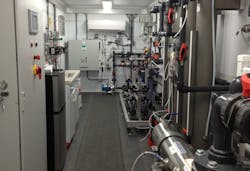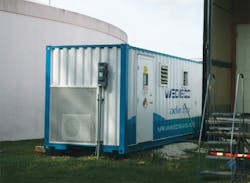City Validates Innovative Reuse Treatment Options Without RO
Hollywood, Florida’s 55.5 MGD Southern Regional Wastewater Treatment Plant (SRWWTP) treats wastewater from Hollywood and six neighboring municipalities in the southern region of Broward County. Florida’s outfall rule requires the city to begin a process to largely eliminate the use of its ocean outfall and implement 20.4 MGD of additional reuse water on an annual basis.
SRWWTP effluent chloride levels are more than 1,000 mg/L, far exceeding threshold levels that make certain reuse strategies economically feasible, thereby necessitating costly reverse osmosis (RO) treatment. This, plus the cost for the necessary piping network, would bring costs for compliance close to $1 billion.
A preliminary evaluation of alternative reuse options identified Floridan Aquifer recharge through direct injection as potentially the most economical method of compliance. The aquifer has high levels of sodium and chloride, averaging 1,100 mg/L and 2,100 mg/L, respectively. When used for potable water supply, the aquifer water requires RO to reduce total dissolved solids (TDS) prior to distribution. The city determined that directly recharging the aquifer with SRWWTP effluent could be the most economical option because it could allow it to avoid the expense of using RO to remove chloride and other salts prior to pumping into the groundwater.
Pilot Study
In 2014, the city and its engineering consultant, Hazen and Sawyer, conducted a comprehensive pilot study to determine and demonstrate advanced treatment technologies that were likely to be the most cost effective while providing reduced carbon emissions compared to the county’s typical treatment requirement of microfiltration, reverse osmosis, ultraviolet disinfection and advanced oxidation (MF/RO/UV-AO). The study also established basic process performance criteria for full-scale planning and design.
For the study, Hazen and Sawyer selected a MiPRO-AOP pilot container from Wedeco, a XYLEM company, which allowed for testing every type of advanced oxidation process (AOP) and to simulate full-scale performance. The self-contained, 40-foot container was delivered to the plant pre-engineered to the project’s specific requirements, with the ability to use ozone, UV and hydrogen peroxide dosing in virtually any strength and combination.
The pilot container also allowed for varying flows of water and contact times throughout the system as well as multiple sample points for real-time monitoring and selective sidestream testing. The unit can operate in both manual and fully automatic modes.
The key to selecting the best AOP solution for Hollywood was to use the sophisticated AOP pilot container to identify the right combination of advanced water treatment processes that would most efficiently reduce the target contaminants. Two treatment schemes designed specifically for removal of emerging contaminants were piloted:
Pilot Scheme 1: Deep bed filters with ion exchange (IX) for removal of total organic carbon (TOC) and ammonia (NH3) with ultraviolet advanced oxidation process (UV-AOP) followed by biological activated carbon (BAC) for emerging contaminant oxidation.
Pilot Scheme 2: Deep bed filters with IX for TOC and NH3 removal, ozone (03), BAC and UV for emerging contaminant removal.
Following startup, pilot testing was performed for approximately 10 months. During this time, the select pilot container processes were operated 24 hours/day, seven days/week, with the exception of scheduled monthly equipment cleanings. A pilot test log was maintained to record daily operations, including the various pilot operational set points for influent flow, deep bed filter backwash frequency, UV, ozone and hydrogen peroxide dosing, and BAC filter flow rate.
Results
Both pilot treatment schemes demonstrated the ability to consistently produce water that is safely within Florida Department of Environmental Protection (FDEP) primary and secondary drinking water standards, plus both successfully oxidized emerging contaminants to levels well below targeted limits (Figure 1.). In addition, pilot-scale testing demonstrated that both treatment schemes are viable options for recharge in Broward County to satisfy the new state reuse requirement mandated by the new outfall rule. The study also demonstrated that the high effluent quality achieved by both pilot schemes could be achieved at substantially reduced costs as compared with other alternatives.
Besides demonstrating how recharging a brackish aquifer would allow Hollywood to comply with Florida’s outfall rule while providing effective emerging contaminant oxidation without RO, the pilot study also showed that the treatment approach using either non-membrane pilot scheme would substantially lower carbon emissions. To meet county standards, either pilot treatment scheme would be expected to release approximately half the amount of carbon dioxide equivalent (CO2e) than that of traditional treatment methods.
The specialized MiPRO-AOP pilot container provided the city an efficient method for evaluating multiple treatment processes using AOP technologies. This enabled Hazen and Sawyer to determine the most efficient solution while saving time and money during the evaluation and preliminary design phases. The MiPRO-AOP pilot container also helped the city establish basic process performance criteria for full-scale planning and design, enabling the city to make the best decisions possible on how to implement its full-scale solution.
Editor's Note: Scranton Gillette Communications and the SGC Water Group are not liable for the accuracy, efficacy and validity of the claims made in this piece. The views expressed in this content do not reflect the position of the editorial teams of Water & Wastes Digest, Water Quality Products and Storm Water Solutions.

